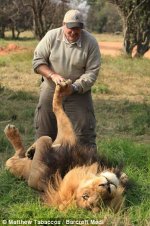omnimegatickler
TMF Poster
- Joined
- Apr 21, 2010
- Messages
- 79
- Points
- 0
Original article here : http://scienceblogs.com/notrocketsc...pes_to_reveal_evolutionary_origins_of_hum.php
"If you tickle a young chimp, gorilla or orang-utan, it will hoot, holler and pant in a way that would strongly remind you of human laughter. The sounds are very different - chimp laughter, for example, is breathier than ours, faster and bereft of vowel sounds ("ha" or "hee"). Listen to a recording and you wouldn't identify it as laughter - it's more like a handsaw cutting wood.
But in context, the resemblance to human laughter is uncanny. Apes make these noises during play or when tickled, and they're accompanied by distinctive open-mouthed "play faces". Darwin himself noted the laugh-like noises of tickled chimps way back in 1872. Now, over a century later, Marina Davila Ross of the University of Portsmouth has used these noises to explore the evolutionary origins of our own laughter.
Davila Ross tickled youngsters of all of the great apes and recorded the calls they make (listen to MP3s of a tickled chimp, gorilla, bonobo and orang-utan). She used these recordings to build an acoustic family tree, showing the relationships between the calls. Scientists regularly construct such trees to illustrate the relationships between species based on the features of their bodies or the sequences of their genes. But this is the first time that anyone has applied the same technique to an emotional expression.
The tree linked the great apes in exactly the way you would expect based on genes and bodies. To Ross, this clearly shows that even though human laughter sounds uniquely different, it shares a common origin with the vocals of great apes. It didn't arise out of nowhere, but gradually developed over 10-16 million years of evolution by exaggerating the acoustics of our ancestors. At the very least, we should now be happy to describe the noises made by tickled apes as laughter without accusations of anthropomorphism, and to consider "laughter" as a trait that applies to primates and other animals
Altogether, Davila-Ross recorded the laughs of 3 human babies, 7 orang-utans, 5 gorillas, 4 chimps, 5 bonobos and 1 siamang (the largest of the gibbons). All of them were playfully tickled by friendly humans in their home environments and on their palms, feet, necks or armpits. Two independent researchers carefully analysed each recording, noting their pitch and timing across 11 different measures. They compared how long the calls were, how many were made, how high-pitched they became, and more.
Her phylogeny of tickled laughter exactly matches the known relationships between the apes - human laughs are most closely related to those of bonobos and chimps, less similar to those of gorillas and most distinct from those of orang-utans and siamangs.
Laughter is very much an instinctive part of human life. Babies who are born deaf can still laugh, and deaf people will laugh while using sign language in the same places that speakers would do. Davila-Ross's study suggests that this innate behaviour has deep evolutionary roots and arose by exaggerating traits found in apes. For example, our laughs are "voiced", meaning that they are made by vibrations of the vocal cords. Among the other apes, laughter usually takes the form of unvoiced noises like huffs and pants, although bonobos did occasionally made voiced calls.
Humans also only ever laugh while breathing out, while other apes can laugh twice on every breath, during both the exhale and the inhale. Chimps, in fact, laugh almost exclusively in this alternating style. Humans compensate for this restriction by being able to exhale a steady flow of air for much longer than a normal breath cycle, a vital ability that lets us speak properly without continually having to catch our breath. Some scientists had thought of this as a uniquely human ability, but the tickle sessions clearly show that gorillas and bonobos can both sustain an exhalation for 3-4 times longer than their normal breath cycle.
The figure below represents Davila-Ross's take on the evolution of laughter. She imagines that the last common ancestor of the apes had a primordial laugh that was longer and slower than ours, consisting of short bursts of noisy calls with little variation between them. Both voicing and long, steady exhalations evolved well before our ancestors split away from those of bonobos and chimps. The rest of our vocal characteristics are just subtle tweaks of those of apes. Of course, this research tells us nothing about why these particular properties developed in the way they did, and what they meant for the evolution of laughter as a means of communication. That will have to wait for future studies.

Reference: Current Biology DOI 10.1016/j.cub.2009.05.028
Images, sound files and videos courtesy over University of Veterinary Medicine, Hannover. "
"If you tickle a young chimp, gorilla or orang-utan, it will hoot, holler and pant in a way that would strongly remind you of human laughter. The sounds are very different - chimp laughter, for example, is breathier than ours, faster and bereft of vowel sounds ("ha" or "hee"). Listen to a recording and you wouldn't identify it as laughter - it's more like a handsaw cutting wood.
But in context, the resemblance to human laughter is uncanny. Apes make these noises during play or when tickled, and they're accompanied by distinctive open-mouthed "play faces". Darwin himself noted the laugh-like noises of tickled chimps way back in 1872. Now, over a century later, Marina Davila Ross of the University of Portsmouth has used these noises to explore the evolutionary origins of our own laughter.
Davila Ross tickled youngsters of all of the great apes and recorded the calls they make (listen to MP3s of a tickled chimp, gorilla, bonobo and orang-utan). She used these recordings to build an acoustic family tree, showing the relationships between the calls. Scientists regularly construct such trees to illustrate the relationships between species based on the features of their bodies or the sequences of their genes. But this is the first time that anyone has applied the same technique to an emotional expression.
The tree linked the great apes in exactly the way you would expect based on genes and bodies. To Ross, this clearly shows that even though human laughter sounds uniquely different, it shares a common origin with the vocals of great apes. It didn't arise out of nowhere, but gradually developed over 10-16 million years of evolution by exaggerating the acoustics of our ancestors. At the very least, we should now be happy to describe the noises made by tickled apes as laughter without accusations of anthropomorphism, and to consider "laughter" as a trait that applies to primates and other animals
Altogether, Davila-Ross recorded the laughs of 3 human babies, 7 orang-utans, 5 gorillas, 4 chimps, 5 bonobos and 1 siamang (the largest of the gibbons). All of them were playfully tickled by friendly humans in their home environments and on their palms, feet, necks or armpits. Two independent researchers carefully analysed each recording, noting their pitch and timing across 11 different measures. They compared how long the calls were, how many were made, how high-pitched they became, and more.
Her phylogeny of tickled laughter exactly matches the known relationships between the apes - human laughs are most closely related to those of bonobos and chimps, less similar to those of gorillas and most distinct from those of orang-utans and siamangs.
Laughter is very much an instinctive part of human life. Babies who are born deaf can still laugh, and deaf people will laugh while using sign language in the same places that speakers would do. Davila-Ross's study suggests that this innate behaviour has deep evolutionary roots and arose by exaggerating traits found in apes. For example, our laughs are "voiced", meaning that they are made by vibrations of the vocal cords. Among the other apes, laughter usually takes the form of unvoiced noises like huffs and pants, although bonobos did occasionally made voiced calls.
Humans also only ever laugh while breathing out, while other apes can laugh twice on every breath, during both the exhale and the inhale. Chimps, in fact, laugh almost exclusively in this alternating style. Humans compensate for this restriction by being able to exhale a steady flow of air for much longer than a normal breath cycle, a vital ability that lets us speak properly without continually having to catch our breath. Some scientists had thought of this as a uniquely human ability, but the tickle sessions clearly show that gorillas and bonobos can both sustain an exhalation for 3-4 times longer than their normal breath cycle.
The figure below represents Davila-Ross's take on the evolution of laughter. She imagines that the last common ancestor of the apes had a primordial laugh that was longer and slower than ours, consisting of short bursts of noisy calls with little variation between them. Both voicing and long, steady exhalations evolved well before our ancestors split away from those of bonobos and chimps. The rest of our vocal characteristics are just subtle tweaks of those of apes. Of course, this research tells us nothing about why these particular properties developed in the way they did, and what they meant for the evolution of laughter as a means of communication. That will have to wait for future studies.

Reference: Current Biology DOI 10.1016/j.cub.2009.05.028
Images, sound files and videos courtesy over University of Veterinary Medicine, Hannover. "








